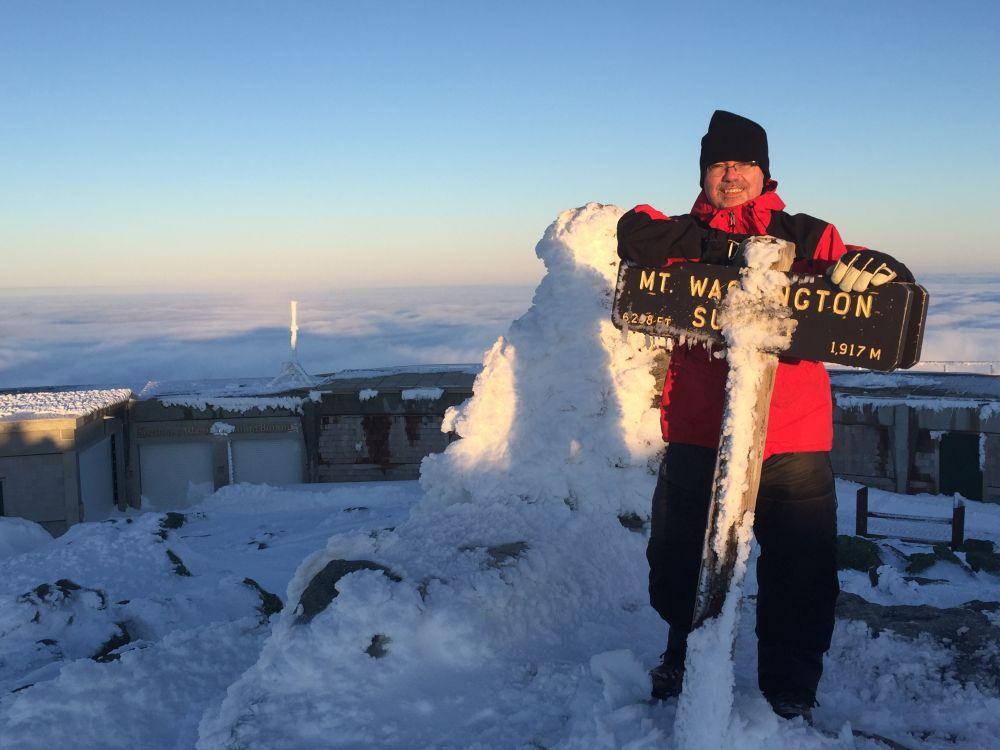No matter the temperature, we'll keep you connected with the natural world.

Dan Szczesny, one the speakers for the series, poses on Mt. Washington summit. (Courtesy)
Our "Cold is Cool" outreach program will keep you connected with the outdoors safely, whether you are isolating at home or trying out winter hiking for the first time. Plug in to watch and learn from expert speakers and then unplug outside! We'll also explore why it's important that our winters stay cold and snowy, as so many local animals, plants and other wildlife have specifically adapted to thrive under these conditions.
The speaker series kicked off on January 6. You can register for the free Zoom presentations on our events page and if you miss a speaker, we'll be posting the recording of each program here.
March 18: Wild Apple Tree Pruning with Nigel Manley
In this pre-recorded presentation, Nigel Manley provides a basic introduction to releasing and pruning wild apple trees. Manley is the director of the Forest Society's North Country Property, including The Rocks. Releasing and pruning wild apple trees can keep them healthy and result in greater fruit production for a wide variety of wildlife.
[Captions are automatically generated and may contain errors.]
February 24: Sugar Maple Regeneration with Dr. Natalie Cleavitt
Cornell University Research Associate Natalie Cleavitt shares her research about New Hampshire’s sugar maples and their ability to regenerate successfully in our changing forests.
Sugar maples are one of New Hampshire’s most important tree species, whether you look at this from an economic, environmental, or cultural perspective. Long term research on sugar maples at Hubbard Brook Experimental Forest in Woodstock, NH has uncovered a significant decline in sugar maple regeneration success over the past 30 years. Seedling sugar maples are having difficulty surviving, which is likely due to a combination of factors including soil acidification, winter weather pattern changes due to climate warming, and increased competition with other tree species. A new community science project began in 2018 to help determine whether the sugar maple regeneration failure seen at Hubbard Brook is happening throughout New Hampshire. Four Forest Society forest reservations are study sites for this project.
Join Natalie Cleavitt, lead scientist on the Sugar Maple Regeneration Community Science Project (SMRCSP) as she explains why sugar maple regeneration may be threatened in our state, what she has learned at Hubbard Brook Experimental Forest, and what the early data from the community science project looks like. We welcome your questions about sugar maples and forest dynamics, and hope you’ll come away with a greater understanding of the challenges facing one of our most iconic New Hampshire trees.
Learn more:
- Read more about the Forest Society's Sugar Maple Regeneration Study, a community science project in collaboration with the Hubbard Brook scientists;
- A Forest Journal article on the project, Minding the Sugar Babies;
- Paleontological Research Center: Sugar Maples and Climate Change;
- Cornell Chronicle article on the students involved in the project;
- Resources on maple sugaring can be found on our Cold is Cool page.
February 17: Climate, Carbon & Forests with Ecologist John Campbell
- Hubbard Brook Ecosystem Study
- Something Wild: Bend But Don't Break: How Trees Survive Northern Winters
- Forest Society archive of articles and news on climate change
January 27: Rediscovering Mount Washington's Hidden Culture with Dan Szczesny
Over the course of a calendar year, Journalist Dan Szczesny explored the history and mystique of New England's tallest mountain for his book, "The White Mountain: Rediscovering Mount Washington's Hidden Culture." Mount Washington is more than just a 6,288-foot rock pile; the mountain is the cultural soul of climbers, hikers, and tourists from around the world looking to test their mettle against some of the most extreme conditions in return for a chance to be inspired by its intense natural beauty. Szczesny is a long-time author and journalist living in New Hampshire. Learn more about Dan.
This event is part of the Forest Society's Cold is Cool speaker series, keeping you connected with the natural world from home. Plug in to watch and learn... then, unplug outside!
(Captions are automatically generated and may contain errors.)
Learn more:
- Dan’s bookstore
- More Books: Cat in the Clouds children’s book; Where you’ll find me by Ty Gagne; Not Without Peril: 150 Years of Midsadventure on the Presidential Range of New Hampshire
January 13: Restoring New Hampshire's Bald Eagle Population with Chris Martin
*This recording was only available for a limited time, as requested by the speaker, and is no longer available.*
Learn more:
January 6: Got Milkweed? Milkweed Community Connections with Katie Galletta
In this pre-recorded, Zoom presentation, join Bowdoin College student Katie Galletta to learn about Monarchs, milkweed and more from her summer-long research project studying interactions between Monarch butterflies and the larger milkweed community. Learn about the perils and protections for insects eating milkweed.
There are 11 specially adapted insect species of that feed on milkweed leaves. “Herbivorous insects on milkweed are from many different orders - there’s the monarch butterfly, but also beetles, flies, aphids, and even a moth.” When a milkweed plants become stressed as insects feed, it can release chemical signals including toxins that Monarchs butterflies sense. When you see a monarch flitting from plant to plant, the butterflies are using their feet and their long tongues to sense chemical markers in the plants.
Galletta visited 28 different study sites across southern New Hampshire, from Portsmouth to Peterborough, including the Forest Society’s High Five Reservation and the Tom Rush Forest in Deering. Many study sites located on lands conserved by municipalities or land trusts including the Forest Society, New Hampshire Audubon and Harris Center for Conservation Education
Learn more:
- A Forest Journal story on Katie Galletta and her research and one on monarchs, milkweed and mowing.
- A book Katie recommends called Monarchs & Milkweed.
- Managing forests for milkweed.
